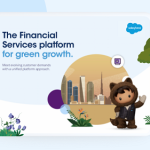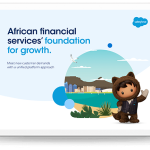Customers are enthusiastic about it. But do banks, insurers and wealth managers have the tools to deliver winning hyper-personalisation strategies that increase satisfaction, retention and revenue?
As consumers, we’re no strangers to personalised marketing. Companies use our data – personal, behavioural, locational – to recommend products or provide tailored services at the right time and place. And while retailers, content platforms, and a raft of organisations in a range of industries have mastered this curated approach, financial services institutions are at an earlier stage of their journey, with fintech firms leading the way within the sector. However, there’s clear and growing interest, driven by advancements in artificial intelligence and data strategies.
For me, personalisation – and increasingly, hyper-personalisation – is about delivering great, fully connected experiences. Being where the customer wants, when they need it, with products that meet their needs and expectations. It’s a concept that’s been around for a while.
Back in the day, personalisation meant using your customer’s name in an email. Now, as we head into an era of hyper-personalisation, things are a bit more sophisticated. We’ve got more data for a start, so we know our customers better. And, in the context of financial services, this is gold.
Demand and disruption
Accelerated digital adoption is a key reason we’ve seen the drive to greater personalisation in most sectors. Lockdowns, of course, played a pivotal role in this, triggering a mass move (out of necessity) to everything online. But there’s also been a general trend towards increased use of digital channels across all ages and demographics. And the more we use and rely on these channels, the more we expect from them.
It’s worth noting here that the quality of the digital experience was the top reason customers switched providers in the past year. That’s across banking (51%), insurance (29%) and wealth management (45%). The upshot is, connected experiences matter.
Competition is another reason banks and other financial services organisations need to raise their game. If customers are craving personalisation and connectivity across digital channels, they can get it from challenger banks, fintechs, and big tech firms today. Unencumbered by legacy technology, taking advantage of open APIs and a new open banking landscape spurred by regulation, they’re demonstrating what can be achieved when you use data in an agile way. It’s a lesson to all financial services players.
Challenges and considerations on the path to personalisation
Infrastructure modernisation is a key hurdle for many banks, insurers and wealth managers. If you’ve got siloed data sitting within legacy systems, it’s very difficult to gain a 360-degree view of your customer. Pulling this data together – not just internal data but from external sources too – is crucial because it gives you a single source of the truth that can be used in your interactions with customers across different channels.
Some of our recent research shows that the average customer now uses 10 different channels to communicate with companies. And they expect to receive the same high level of engagement across them all. Whether through a portal, on the phone, via chat, or email. They want personalised responses that show understanding and add value to their journeys, even as they jump from one channel to another.
The solution to combining this data and ensuring consistency across channels can be simple.
One Salesforce customer, Edelweiss Global Wealth Management, gave its financial advisors access to real-time customer information through the Salesforce mobile app. With a total view – customer interactions, history, profiles, and feedback – advisors now close cases within the agreed service level agreement 97% of the time, boosting customer satisfaction.
In the pursuit of getting more out of data, there’s an obvious and important issue around trust. Banks, insurers and wealth managers need to use data well to ensure customer trust.
Research has shown that 55% of consumers say they trust banks and financial services providers with their personal data. This is ahead of other organisations including hospitals, government agencies and airlines. It’s a high level of confidence. And arguably a decent indicator that if customers get a better experience – tailored services at the right time, for instance – they’d be happy for more of their data to be used.
The key is to ensure a fair exchange. And that consumers’ data remains safe at all times.
Driving loyalty with intelligence
The ultimate in customer-centric service is the end game of the whole process. In a way, it’s striving to capture the personal approach of past times. Like face-to-face meetings with a bank manager who acts as an adviser throughout your lifetime. Knowing you’re looking to move house, you’re about to have a baby, you’re planning retirement. Whatever the life event might be.
While most of us haven’t experienced knowing our bank managers, we can all appreciate the value of the personal touch at critical junctures in our lives. And the fact that someone understands the hurdles in your life as – or even before – they arise. At a time when customers are looking for greater support – 79 per cent said they didn’t feel their financial service provider helped them fully prepare for economic uncertainty – the opportunity is huge.
Financial services organisations that master their role as advisors in the digital age. That provides a seamless experience across multiple channels. They predict their customers’ needs with accuracy, not intrusion. These are the businesses that will build trust, increase engagement, and drive life-long loyalty.
This brings us to an interesting point about loyalty. It’s often not just about the individual.
Financial decisions made by one family member intrinsically affect numerous other family members. An organisation that has a trusted relationship with one customer has a significant opportunity to build on that, through personalisation, to other members of the family. So there’s a lot to be gained by getting that initial relationship right.
Making it personal in financial services
Knowing your customer is the first step. DMI Finance, for example, built its personalisation strategy around its customer relationship management system.
At the back end, the platform interacts with multiple systems enabling up to 40 API-led know-your-customer checks. It brings together data from supply chain partners and service providers, as well as customers. It integrates over 20 apps for credit decision-making. And, as all this goes on in the background, DMI Finance’s customers experience a seamless service and get credit decisions in less than one minute.
My point is, no matter how complex your systems are, when you have your data in order – and the agile technology to drive it – knowing your customer becomes much easier.
Then, with analytics, you can reach insight. From the basics like what channel customers prefer, to the more advanced state of being able to recommend (or approve) products, services or actions based on behavioural data. Whether that’s giving customers sustainable investment options as they build their portfolios, or suggesting to a parent to start saving for their child’s university education. Using machine learning and artificial intelligence, you can understand what customers want to achieve and use that information to support them through their lives in a meaningful way.
But this is just the near future for personalisation in financial services. The next level – beyond banking – will see personalisation supercharged as financial services organisations partner with third-party brands to build a trusted community of interconnected providers.
This represents the transition from open banking to open finance. And the ability to leverage more far-reaching sets of data than ever before.
With customer trust coupled with the right technology, I believe it’s a vision that any financial services business can confidently step into, further transforming experiences through new levels of personalisation.
Connect with Customers Using Financial Services Cloud
Use Financial Service Cloud features to collaborate with your customers.

























